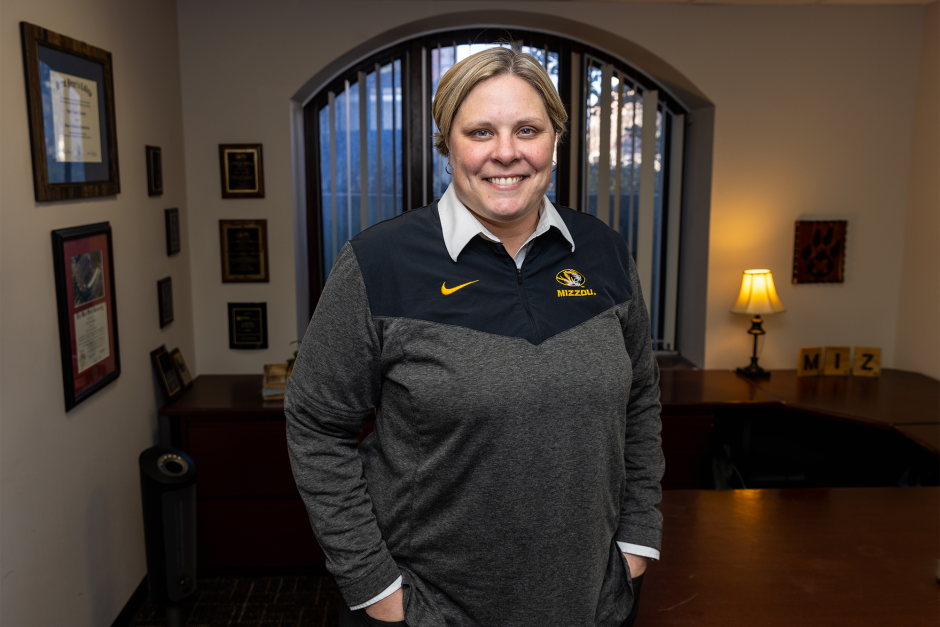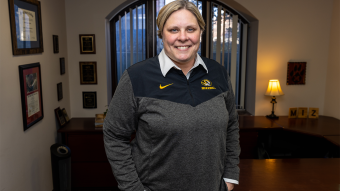
Jan. 2, 2024
Contact: Brian Consiglio, 573-882-9144, consigliob@missouri.edu
Editor's note:
Due to a recently updated deadline from the state of Missouri, April 1 is now the final FAFSA submission deadline for being considered for MU and state need-based financial aid programs. However, MU strongly encourages FAFSA submission by March 1 to initially get the most complete financial aid offer.
Emily Haynam, the University of Missouri’s executive director of student financial aid, has more than a decade of experience working in higher education financial aid. After hearing about the biggest change to the Free Application for Federal Student Aid (FAFSA) in 40 years, Haynam reached out to colleague Matthew Kearney, president of the Missouri Association of Student Financial Aid Personnel (MASFAP). Together, they built a coalition of financial aid professionals from public and private universities and community colleges across Missouri united under two common goals: help more Missourians go to college and maximize the amount of financial aid they are eligible for.
Read on for a Q&A with Haynam and Kearney about the changes to FAFSA.
How is FAFSA changing?
Haynam: A new federal law, the FAFSA Simplification Act, was created to simplify and streamline the application process, reduce barriers and increase access to financial aid by more accurately determining eligibility for federal aid. The biggest change is reducing the application length from more than 100 questions to as few as 18 for some applicants.
How will the changes impact need-based financial aid availability for MU students?
Haynam: In terms of how aid gets calculated, the new formula will more heavily weigh a family’s adjusted gross income and total household size. As a result, the University of Missouri estimates approximately 1,500 more MU students will become eligible for Federal Pell Grants (money from the federal government to help students from low-income families pay for college). MU’s Missouri Land Grant program helps Pell Grant-eligible Missourians by covering 100% of their tuition upon admission to Mizzou. Therefore, the changes will potentially allow more students to attend MU tuition-free.
When is the 2024-2025 FAFSA available?
Haynam: The application period opened Jan. 1. To get started, students will need to obtain a Federal Student Aid ID. Although it’s simple to create, it will take three days to process.
What is MU's deadline for FAFSA submission?
Haynam: We strongly encourage FAFSA submission by March 1 to initially get the most complete financial aid offer. However, April 1 is the final deadline for being considered for MU and state need-based financial aid programs.
How is MU helping Missouri students and their families navigate the new process?
Haynam: From Jan. 8-11, MU’s Office of Student Financial Aid will be partnering with MASFAP to host a statewide “FAFSA Week of Action.” Each night from 5:30 to 8:30 p.m., financial aid officers from universities across Missouri, including MU, will be available via zoom to help students and families with specific FAFSA-related questions.
On Jan. 24, MU’s Center for Academic Success and Excellence and TRiO Student Support Services will host a FAFSA workshop. The event will be at 4 p.m. in MU’s Tate Hall.
How has MU helped make the cost of attending college more affordable?
Haynam: One recent policy change our office made to increase affordability is allowing MU scholarships awarded by specific academic units or departments to be stacked on top of MU’s Missouri Land Grant program so that the money can be used for non-tuition college expenses. In addition to Pell Grant-eligible Missourians having 100% of their tuition already covered upon admission to MU, the scholarship money awarded by specific academic units or departments can be used to help with food, housing and other non-tuition college expenses.
We’re always looking at ways to help maximize the amount of aid MU students are eligible for, and those efforts have paid off — MU continues to rank among the best value of national universities, including the No. 1 rank among public national universities in neighboring states (Illinois, Iowa, Nebraska, Kansas, Oklahoma, Arkansas, Kentucky and Tennessee), according to U.S. News & World Report.

How did the coalition between MU and MASFAP come about?
Kearney: As the president of MASFAP, I meet regularly with Emily Haynam and the other MASFAP delegates with various universities across the state. When she approached me with the idea of working with MASFAP delegates and directors of student financial aid throughout Missouri to put together a virtual “Week of Action,” I thought it was a great idea for universities across Missouri to collaborate under a united coalition. We all have the same goal: to increase the amount of Missourians attending college, and this coalition is committed to raising awareness about the importance of completing the FAFSA, regardless of where students choose to enroll. Attending college opens up a variety of opportunities for students to grow personally and professionally.
What does it mean to have MU as part of the coalition?
Kearney: As the state’s flagship institution, MU has a lot of name recognition. We believe this collaborative partnership can help raise awareness about the FAFSA by reaching Missourians in all four corners of the state.
If we can accomplish our goal of more Missouri students and families filling out the FAFSA and attending college, they will be more likely to get higher-paying jobs, which increases upward mobility and improves the chances of building generational wealth, particularly for first-generation college students. That is why the goal of this coalition is to help students think about when and where to go to college, not if they should go to college.
